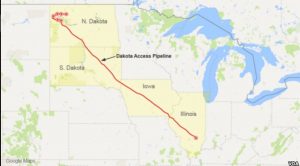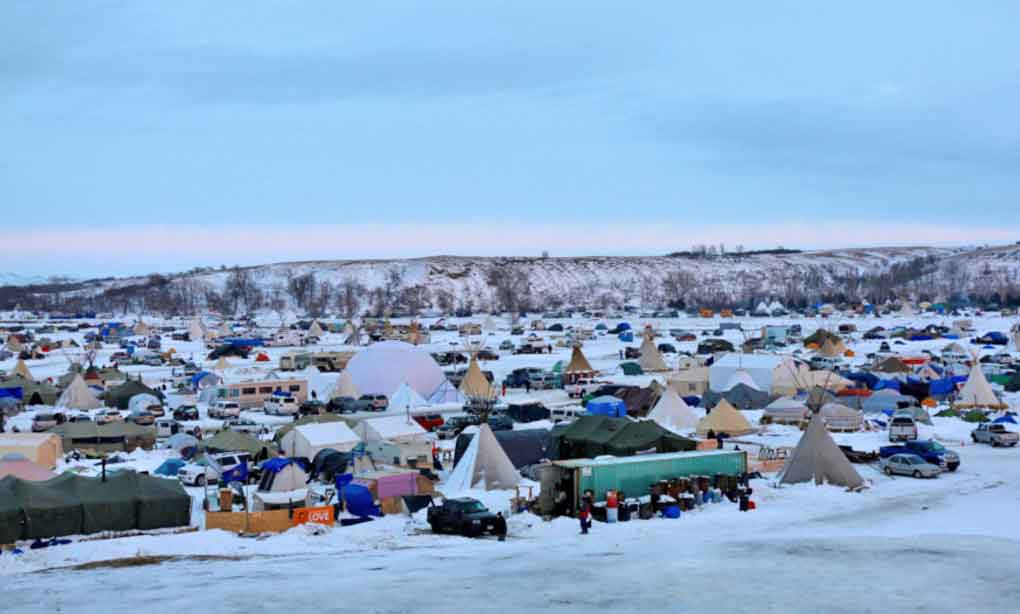
Lakota Sioux Indians and their supporters across the country are celebrating the U.S. federal government’s decision to temporarily halt construction of a $3.8 billion oil pipeline that would cross treaty land seized from the Standing Rock Sioux Nation decades ago. But the issue is far from settled.
The plan was for the Dakota Access Pipeline to stretch from North Dakota’s Bakken oil fields to Illinois, carrying about a half million barrels a day of Texas-based Energy Transfer Partners’ (ETP) “light, sweet crude.” Originally, the pipeline was designed to cross the Missouri River near the state capital, Bismarck.
But the U.S. Army Corps of Engineers worried that could threaten the city’s water supply, so they changed the route to cross over lands seized decades ago from the Standing Rock Sioux tribe at Lake Oahe, about a half mile from the reservation’s border. Worse, say tribal leaders, they were never consulted about the change in plans.
In April, citizens of the Standing Rock Sioux Nation and allied tribes set up the Sacred Stone Camp at the site of the proposed pipeline crossing. It has now grown to a sprawl of tents and campers inhabited by hundreds of people.
They say the pipeline would not only violate land that is sacred to the Lakota people, but pose a threat to the reservation’s own water resources.
“This is huge,” said attorney and Native American activist Chase Iron Eyes, a Democrat who is currently running for North Dakota’s only U.S. House seat. “It’s definitely the largest gathering of tribes in our history. In 1851, the United States sent word out inviting maybe about 20 tribes to the signing of the Fort Laramie Treaty. But we counted 140 separate tribes at Sacred Stone yesterday.”
In the Fort Laramie Treaty, the U.S. agreed on the Sioux tribes’ sovereign land in the Black Hills. The federal government promised to pay the tribes $50,000 dollars annually for 50 years if the tribes gave safe passage to settlers crossing that land. A year after signing, the U.S. changed the terms and began building forts in the area.
The state also filed warrants against Green Party presidential candidate Jill Stein and her vice-presidential running mate Ajamu Baraka for spray painting slogans on construction equipment.[xyz-ihs snippet=”adsense-body-ad”]
Iron Eyes blamed local media for trying to portray the peaceful and unarmed protests as unruly, unlawful and unwarranted.
“The pipeline company could have avoided all of this if they had just left the pipeline above Bismark, where it was set to go,” said Iron Eyes. “In fact, they could have avoided the Missouri River in its entirety and routed the pipeline completely on the east side of the Missouri River, avoiding all protests and all the hassles we’re now seeing.”
The hacktivist group Anonymous has weighed in against the pipeline and the use of violence against peaceful protesters, posting a YouTube video threatening ETP co-founder and CEO Kelcy Warren, as well as North Dakota’s National Guard, which has been authorized to take action against protesters.
In a joint statement Friday, the U.S. Departments of Justice, Army and Interior requested a halt to all pipeline construction for 20 miles east or west of Lake Oahe and expressed support for the rights of Native and all Americans to assemble and protest. That said, they cautioned that any violence or destruction could be met by sanctions at the federal, tribal, state or local levels.
The halt is only temporary and only covers the part of the pipeline under construction on the 20 miles on either side of the river.
“Construction everywhere else along the nearly 1,200-mile corridor is fair game right now,” said Iron Eyes, who will join former Democratic presidential contender U.S. Senator Bernie Sanders in front of the White House Tuesday and call on President Barack Obama to stop the Dakota Access pipeline completely.
Sanders has introduced the Water Resources Development Act of 2016 which, if enacted, would prevent the U.S. Army Corps from building the 40-mile stretch of the pipeline at Lake Oahe until the agency has completed an environmental impact statement, a much more arduous process, said Iron Eyes, than the environmental assessment the Corps is currently reviewing.
If, however, protesters can’t stop the pipeline, construction will continue, said Iron Eyes.
“And about 5,000 peaceful, civil disobedient U.S. citizens will put themselves in the way of the construction,” he added.
But this isn’t just a native dispute, he stressed.
“Something big is happening in terms of the economic system, the economic reality that we are all born into which ultimately boils down to extractive economies and currency,” he said, “systems that assume that earth’s resources are limitless.”
Source: VOA [xyz-ihs snippet=”Adversal-468×60″]








